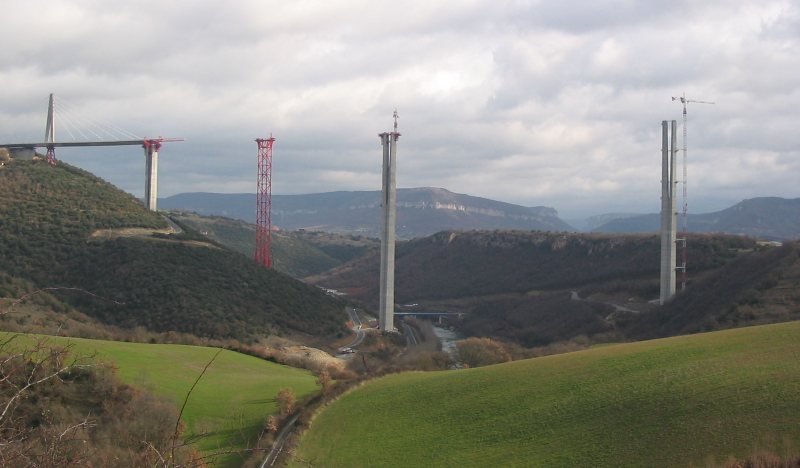>> Slow news day? I think not! Two articles in the Post-Gazette. One's about literal bridges, the other about metaphorical ones.
PennDOT offering private sector a partnership to fix bridges
At least 500 decaying bridges would be replaced starting in 2015 under a partnership in which a private entity would be selected to design, build and maintain the bridges, in exchange for payments from PennDOT that would be tied to performance.>> Apparently, this plan has been circulating unofficially for three or four months.
"A great portion of my members are very interested in this program," said Eric Madden, executive vice president of the American Council of Engineering Companies of Pennsylvania, comprising more than 125 companies.>> This is the kind of public-private partnership that should enrage a population. A number of reasons:
>> 1) Infrastructure is an absolute bedrock of governmental function. It is the classic example of a 'public good' - a useful service which benefits all citizens and businesses, a common carrier used by all. Its maintenance is the minimum standard to which any governing body in any location should be held. To forfeit not just the maintenance of transportation infrastructure of the state, but it's management as well is, in essence, to hand the Mantle of Heaven to private industry. To whit:
>> 2) Furthermore, such a partnership would not absolve PennDOT from it's actual job, listed as the following mission statement: "Through the active involvement of customers, employees and partners; PENNDOT provides services and a safe intermodal transportation system that attracts businesses and residents and stimulate Pennsylvania's economy." That is to say, such a partnership would not be an expansion of PennDOT's mission or reach or scope, but simply an abdication of the organization, and a literal passing of the buck down the line to private industry. It would be not so much a public-private partnership as it would be a simple giveaway.
>> 3) Even further, despite the supposed cost-savings listed in the article, such a partnership would invariably send any proceeds into the hands of private businesses, and keep any problems public. What happens when the eventual winning bidder declares bankruptcy five years down the line? I'm sure there would be much legal wrangling, and I'd bet top dollar that the state would, in the end, eat the costs.
>> 4) Finally, if one were to ignore the first three points, and accept the potential partnership, a question arises: If PennDOT has hired outside firms to manage the reconstruction and ongoing maintenance of the bridges, and that (hope against hope) seems to be going well, why are we still paying PennDOT to do anything? The prospect of any governmental agency privatizing much of its function and reducing itself to the roll of toll-collecting middleman is a monstrous ethical tangle. We (the citizens) would essentially pay the Commonwealth to employ gatekeepers whose sole job it is would be to extract their cut from any contract made with private industry. (Like the Turnpike Commission? HEY-OH!)
>> On to article two!
Conservator asks to liquidate August Wilson Center assets
Faced with a dire financial situation, the conservator for the August Wilson Center for African American Culture is asking for court permission to liquidate the facility's assets.>> The AWC was always meant to be a metaphorical bridge. From its location in the Downtown Cultural District, to its partnership with the Cultural Trust, to its overall mission of "preserving, presenting, interpreting, celebrating and shaping the art, culture and history of African Americans in Western Pennsylvania and people of African descent throughout the world," the center was always meant as a means to showcase the cultural works of the 26% of the city's population who "increasingly question whether [Pittsburgh] is truly livable for and welcoming to us." And yet despite these good intentions, it all went terribly awry, and in the absence of a timeline, mission, or vision, the vultures have been called in to pick at the bones.
In an interim report filed today, Judith Fitzgerald, a former U.S. bankruptcy court judge, said she sees "no possibility of continued viability of [the August Wilson Center] as it currently exists."
She recommended that her appointment be converted to a liquidating receivership to sell the center and its assets.
>> I'm of two minds on this. One mind makes the connection between the two articles, ignores race, and points to the AWC as an exemplar boondoggle in a long history of municipal boondoggles, especially those involving externally driven "development through the arts", as if airdropping culture into a block improves that block. Whatever happens to the building, and hopefully something sensible happens to it, the taxpayers will end up footing some significant portion of the bill.
>> The other mind makes that race connection, and wonders whether the mostly preventable fall of an explicitly African American cultural center implies that, to paraphrase the biggest worries of the Pittsburgh for Trayvon organization, "Pittsburgh might be a city where property is valued over Black lives."
>> Today is certainly a day where the commons looks to be tragic. Both bridge narratives point to a general mortgaging of the future, abdication of responsibility, and lack of leadership. Both serve as cautionary tales for the incoming mayor, who made bridges a signature visual theme in his campaign.


No comments:
Post a Comment